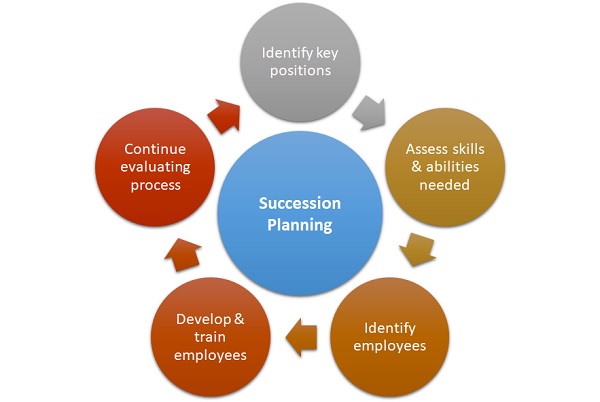Succession planning and career advancement are crucial aspects of professional growth and development. Whether you are an aspiring professional looking to climb the corporate ladder or an experienced employee preparing for future leadership roles, having a well-defined plan and strategy is essential. By proactively engaging in succession planning and focusing on career advancement, individuals can position themselves for long-term success. This involves identifying career goals for freshers jobs, acquiring necessary skills and knowledge, seeking growth opportunities, building strong professional networks, and continuously adapting to the industry’s evolving demands. In this dynamic and competitive business landscape, mastering the art of succession planning and career advancement is key to unlocking new opportunities, achieving personal fulfilment, and reaching professional heights.

Initially, let us know what Succession Planning is.
Succession planning is a strategic process undertaken by organisations to identify and develop potential future leaders within their ranks. It involves identifying key positions or roles within the company critical for its long-term success and creating a plan to make sure a smooth transition when those positions become vacant due to retirement, promotion, or other reasons.
Succession planning aims to mitigate the risks associated with leadership gaps by identifying and grooming internal talent to step into leadership roles. What is succession planning? This process typically involves assessing current employees’ skills, performance, and potential, providing training and development opportunities, and creating a pipeline of capable individuals ready to assume higher-level responsibilities. Organisations can ensure continuity, maintain institutional knowledge, foster employee engagement and loyalty, and facilitate a seamless leadership transfer when needed by implementing effective succession planning.
What is the succession planning process?
The succession planning process is a comprehensive and strategic approach undertaken by organisations to identify, develop, and prepare potential future leaders within their ranks. This process of succession planning ensures the continuity and sustainability of the organisation by proactively addressing leadership gaps that may arise due to retirements, promotions, or other factors. The succession planning process typically involves several key steps, each contributing to the program’s effectiveness.
The first step in the succession planning is establishing clear organisational objectives and goals. This includes understanding the long-term strategic vision of the organisation, identifying critical positions that require succession planning, and determining the competencies and skills necessary for success in those roles.
Once the objectives are set, the organisation must identify and assess the potential candidates for leadership positions. This involves evaluating the current workforce and identifying individuals who demonstrate the potential to take on future leadership roles. The assessment may include performance evaluations, skills assessments, and interviews to identify potential candidates’ strengths and development areas.
With a pool of potential successors identified, the next step is to create individual development plans for each candidate. These plans outline the specific actions, training, and experiences required to prepare the individuals for their future leadership roles. Development activities may include job rotations, mentoring programs, executive coaching, formal training programs, and stretch assignments. The development plans should be customised to address each individual’s unique needs and career aspirations, aligning their growth with the organisation’s strategic objectives.
In addition to individual development planning stages, organisations should also focus on creating a learning and development culture that supports the overall succession planning process and earn a high freshers salary. This involves providing opportunities for continuous learning, knowledge sharing, and skill development at all levels of the organisation.
This can be done through various training programs, workshops, leadership development initiatives, and knowledge-sharing platforms. By fostering a culture of continuous learning, organisations ensure that potential successors are equipped with the necessary skills and competencies to thrive in their future roles.
Communication plays a vital role in the succession planning process. It is essential to have open and transparent communication with potential successors to keep them engaged and motivated. Regular feedback sessions, performance discussions, and career conversations help candidates understand their progress, areas for improvement, and future opportunities within the organisation. Communication also extends to sharing the succession planning process with all stakeholders, including senior leaders, managers, and employees. This ensures transparency and builds trust, fostering a positive organisational culture.
Another critical aspect of the succession planning process is monitoring and reviewing progress. Regularly assessing the development and performance of potential successors allows organisations to gauge their readiness for future leadership roles. This involves tracking key performance indicators, evaluating the effectiveness of development plans, and making necessary adjustments to ensure continuous improvement. Regular check-ins, performance reviews, and talent review meetings are essential for monitoring.
For better Succession Planning and career development at your jobs, you can look out for freshers jobs in Hyderabad.
As the organisation approaches the final stages of the succession planning process, it is crucial to validate the readiness of potential successors through simulated or real-life leadership experiences. This can include assigning individuals to lead projects, task forces, or cross-functional teams to test their leadership capabilities in a controlled environment. The insights gained from these experiences help validate the readiness and identify gaps that must be addressed before the individuals assume leadership roles.
The last steps for succession planning is implementing the transition when a leadership vacancy occurs. This involves effectively communicating the transition plan to the organisation, ensuring a smooth handover of responsibilities, and supporting the newly appointed leader. The outgoing leader may play a mentorship role during the transition period to facilitate knowledge transfer and ensure a seamless transfer of leadership.
Succession planning is an ongoing and iterative process. It requires continuous evaluation, refinement, and adjustment as the organisation and its leadership needs evolve over time. By investing in succession planning, organisations can build a robust leadership pipeline, minimise disruptions, retain top talent, and drive long-term success.
What succession planning means for your career
Succession planning significantly shapes an individual’s career trajectory and can have profound implications for professional growth and advancement. By understanding and actively engaging in the succession planning process, individuals can strategically position themselves for future leadership roles and maximise their career and job opportunities.
One of the most important benefits of succession planning for your career is the opportunity for advancement. Succession planning identifies high-potential individuals within an organisation who demonstrate the capabilities and qualities required for leadership positions. By actively participating in the succession planning process, you increase your visibility and the likelihood of being considered for future leadership roles. This recognition can open doors to promotions, increased responsibilities, and expanded opportunities for professional growth.
Engaging in succession planning also allows you to align your career goals with the organisation’s strategic objectives. You can proactively develop and acquire the necessary expertise by understanding the competencies and skills required for leadership roles. This may involve seeking specific training programs, gaining relevant experience, or expanding your knowledge in key areas. By aligning your development efforts with the organisation’s succession planning initiatives, you position yourself as valuable and showcase your commitment to the organisation’s long-term goals.
What is succession planning? Succession planning provides you with a clear roadmap for career progression. By actively participating in the process, you gain insights into the competencies, experiences, and qualifications required for different leadership positions. This understanding lets you set realistic goals and chart a career path. You can identify the necessary steps and milestones that need to be achieved to move closer to your desired leadership role. This roadmap helps you stay focused and motivated, providing a sense of direction and purpose in your career journey.
Moreover, succession planning enhances your professional development. As part of the process, organisations invest in the growth and development of potential successors through training programs, mentoring, coaching, and exposure to challenging assignments. By actively participating in these initiatives, you gain valuable skills, knowledge, and experiences contributing to your professional development. This prepares you for future leadership roles within the organisation and enhances your marketability and attractiveness to potential employers.
TCS company provides great career advancement for every employee in their career planning. Henceforth you can check out Tcs jobs for freshers.
Succession planning also fosters a culture of continuous learning and feedback. As part of the process, you receive regular feedback on your performance, strengths, and areas for improvement. This feedback is invaluable in honing your skills, addressing development needs, and refining your leadership capabilities. Additionally, succession planning often involves mentorship and coaching relationships, providing you with guidance and support from experienced leaders. These opportunities for learning and feedback accelerate your growth and contribute to your long-term career success.
Finally, succession planning provides a sense of stability and security in your career. As organisations prioritise developing internal talent and identifying future leaders, you become part of a talent pool recognised and valued by the organisation. This recognition can increase job security and opportunities for advancement for the process of succession planning within the organisation. Additionally, being part of a well-structured succession planning process gives you visibility and influence in shaping your career trajectory.





